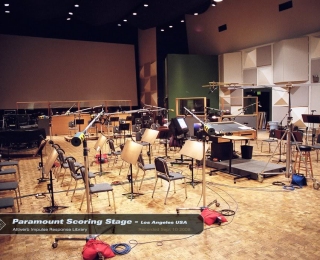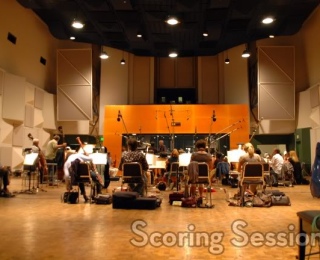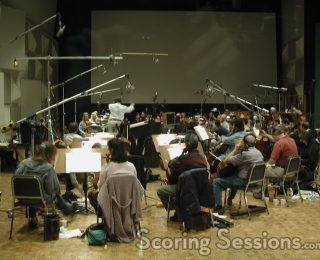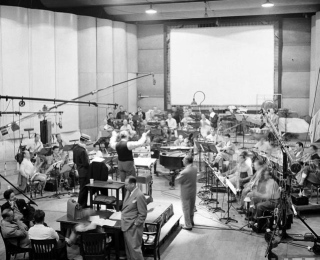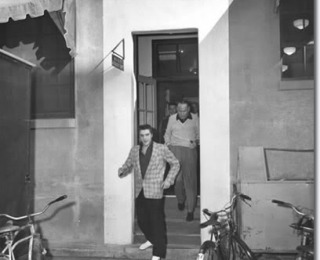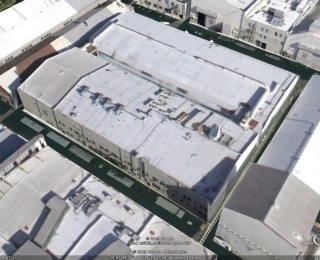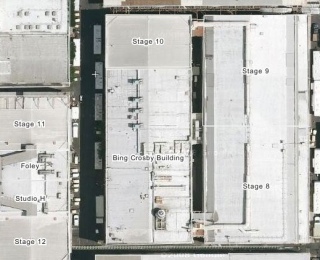Date of Construction: 1922
Date of Demolition: 2008
The Scoring Stage was demolished in late 2008 to make room for the new Post Production Village (opened 2010). All of the Bing Crosby Building complex (including Stage 10, the Scoring Stage and associated offices and workshops) was demolished.
History
Paramount was one of the last major Hollywood studios to have dedicated a stage for scoring. So when pressure built to have a stage converted for recording music, sometime in late 1930, Paramount execs decided to allocate money to take over a small shooting stage turning it into a nice sized scoring stage. The area selected was inside a long building that at one end contained Stage 10, one of the first sound stages built on the Paramount lot. Eventually that building was named after Bing Crosby, and contained offices, a screening room for the music dept. and a looping stage. Rumor had it the entire structure had been moved from the Famous Players-Lasky Studio that was on the corner of Sunset and Vine. Another tall tale was it arrived on a wagon pulled by a team of mules from the corner of Sunset and Gower sometime in 1932. Problem is, there was no stage located on the corner of Sunset and Gower plus the building the scoring stage was eventually located in was built before 1932. I will admit with its V-shaped roof it did resemble the glass walled silent stages that were on the Sunset and Vine lot so who knows? It just might have been disassembled and rebuilt on the Paramount lot. But my guess is, both stories are more legend than fact.
The Paramount scoring stage had inside dimensions of 55′ x 90′ x 30′. As was the case with all the early sound stages designed by Western Electric engineers, a sound monitor booth was installed on the mezzanine level so the sound mixer could be isolated and could look down upon the scene being filmed. That booth was located against the north wall that divided the scoring stage from adjacent Stage 10.
This stage was demolished in late 2008 to be replaced by the new Post-Production facility under construction on the site. The last score to be recorded there was in August 2008 for Thomas Newman’s score for Pixar’s ‘WALL-E’.
Amongst many other recording sessions, Bing Crosby’s White Christmas was recorded here.
The stage was known only as ‘Scoring Stage’ until Glenn Glenn Sound took over operation of the facility in the late 1960s. It was then known as ‘Studio M’ (for ‘Music’). An adjacent stage was named ‘Studio L’.
Organ
Sometime in 1929 before Paramount converted the stage to full time scoring, a Wurlitzer pipe organ was installed, Opus 2035. It can be heard in the 1931 version of DR. JEKYLL AND MR. HYDE. That organ was later sold to NBC where it resided in the studios of KNBC in San Francisco. It’s my belief the organ was originally installed to provide ‘mood’ music to the first six purposefully built sound stages on the lot. Fox Studios at their Movietone facility in West Los Angeles had installed a Wurlitzer (opus 1967) on Stage 1, also before it was converted for scoring. I have an old article describing how that organ could send sound to the first four sound stages built on the lot to provide ‘mood’ for the actors. I guess very quickly they realized that the need for total quiet on the set precluding such music. When Fox’s Stage 1 became the scoring stage, the organ came in handy. It remained at Fox until the late 1990s when it was sold to a private individual. That organ was heard on numerous Fox film scores including THE SOUND OF MUSIC and PATTON.
Very many thanks to Rich at theStudioTour.com forum for the above information.

